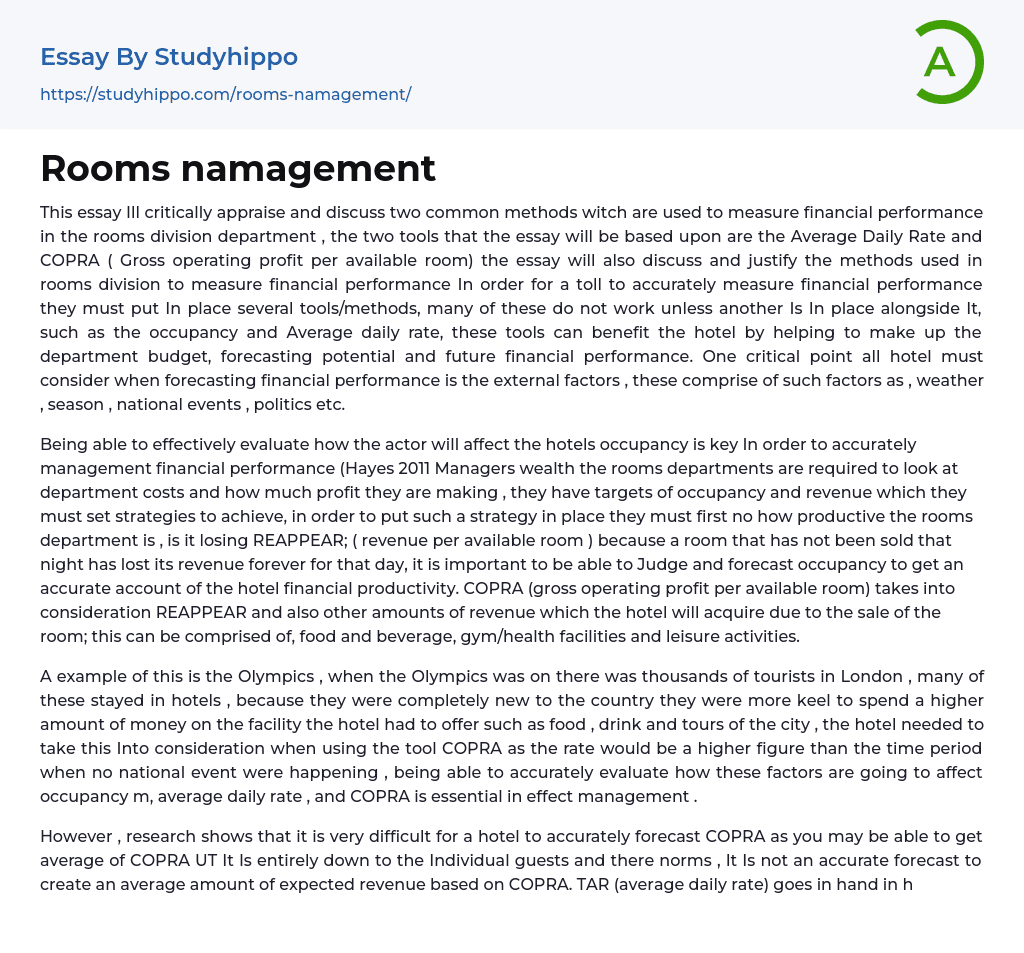This essay aims to critically assess and discuss two widely used methods for measuring financial performance in the rooms division department – Average Daily Rate and COPRA (Gross operating profit per available room). The justification for these methods and other tools used in financial performance measurement will also be discussed. It is important for an accurate measurement of financial performance to incorporate various tools/methods, including occupancy and Average Daily Rate, to facilitate the formulation of department budgets and forecast future financial performance. When forecasting financial performance, external factors such as weather, season, national events, and politics must be taken into account as they can significantly affect occupancy rates. Room department managers need to analyze department costs and profits, set targets for occupancy and revenue, and develop strategies to meet these targets. To implement
...strategies effectively, an understanding of the productivity of the rooms department is necessary.It is crucial to assess occupancy levels to determine a hotel's financial productivity, as an unsold room for the night means lost revenue. To accurately gauge this, the concept of COPRA (gross operating profit per available room) accounts not just for REAPPEAR, but also considers other income sources such as food and beverage, health facilities, and leisure activities. COPRA can be affected by external events like the Olympics, where tourists may spend more on hotel amenities. However, it is challenging to predict COPRA accurately because it depends on individual guest behavior and cannot be based on a typical revenue estimate. Despite this, evaluating occupancy levels, average daily rates, and COPRA remains vital for effective hotel management.The hotel's TAR is closely linked with occupancy, as using only one measurement tool will
not provide a clear financial picture of the hotel's actual status. The average daily rate of a hotel is affected by various factors, including external ones such as weather, natural disasters, and public events like carnivals or concerts. The principle of supply and demand affects both the TAR and occupancy. The use of yield management in conjunction with forecasting financial performance is critical for hotels to consider all factors that impact revenue and profitability. Using both tools effectively is key to accurately forecasting and assessing the hotel's financial performance. This essay will evaluate the advantages and disadvantages of yield management for the organization, its employees, and customers, according to Hayes and Miller's Revenue Management for the Hospitality Industry and Allan's Revenue Management and Hotel Operations.Yield management is a technique used by many industries to extract maximum revenue from a fixed quantity of perishable goods and/or services (Netter 2005). It involves selling a room/product at the right time, on the right day and for the right price, thereby maximizing revenue and effectively maximizing profit (Allan 2012). Despite its advantages, there can be several disadvantages of yield management. For instance, if a hotel increases rates on rooms on a certain weekday because of an event such as a concert that is happening nearby and occupancy is expected to be high, the hotel may generate more revenue and therefore profit. However, regular clients who are not aware of the nearby concert may feel unfairly charged. As a result, this may cause conflict and damage customer relations for the hotel. Furthermore, employees who have to deal with these complaints may also suffer, as they do not benefit directly from
increased custom but have to deal with the problems caused by the hotel's poor yield management practices.When considering yield management in hotels, managers must take certain factors like season/weather, national events such as the Notting Hill carnival, the Queen's Jubilee, and particularly the Olympics into account to appropriately set prices and predict occupancy. Effective use of this tool can result in increased revenue and profit. Yield management is not just about increasing prices; it's about being flexible with rates and availability to increase productivity. For example, during a forecasted slow period with bad weather, it would be wise to decrease prices to increase occupancy. Unsold rooms cannot be sold again, resulting in lost revenue. Therefore, decreasing prices during periods of low occupancy can generate revenue that would otherwise be lost. Offering cheaper prices during times of low demand also fosters positive customer relations and is a good business practice. (Hayes, D & Miller, A., 2011).If a hotel fails to implement effective yield management, they risk losing customers during times of high supply and low demand. This may cause customers to choose a cheaper alternative. Similarly, if a hotel does not increase prices during periods of high demand, they will lose potential profits that could have been gained by charging more for their product due to the increased demand.
- Chief Executive Officer essays
- Convenience Store essays
- Firm essays
- Training And Development essays
- Unilever essays
- Variable Cost essays
- Virgin Group essays
- Bargaining essays
- Entity essays
- Pest analysis essays
- Interview essays
- Job Interview essays
- Career Choice essays
- Career Goals essays
- Portfolio essays
- Community Service essays
- Work-Life Balance essays
- Performance Appraisal essays
- Job essays
- Employee essays
- Skills essays
- Service essays
- Vocation essays
- Internship essays
- Work Experience essays
- Duty essays
- Dream Job essays
- Career Plan essays
- Perfect Competition essays
- Underwriting essays
- Synergy essays
- Valuation essays
- Advertising essays
- Audience Theory essays
- Competitor Analysis essays
- Consumer essays
- Marketing Management essays
- Marketing Mix essays
- Marketing Plan essays
- Marketing Research essays
- Marketing Strategy essays
- Point Of Sale essays
- Price essays
- Procurement essays
- Product essays
- Product Differentiation essays
- Promotion essays
- Promotion And Marketing Communications essays
- Retailing essays
- Trademark essays




